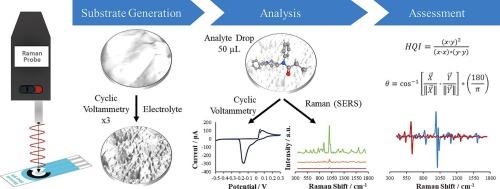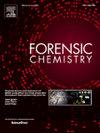Development and evaluation of a nontargeted electrochemical surface-enhanced Raman spectroscopy (EC-SERS) screening method applied to forensic seized drug casework samples
IF 2.6
3区 医学
Q2 CHEMISTRY, ANALYTICAL
引用次数: 0
Abstract
Screening tests in forensic laboratories are a critical step in ensuring an efficient and effective analytical scheme for presumptive identification. Electrochemical surface-enhanced Raman spectroscopy (EC-SERS) represents a novel workflow that can be applied both in the laboratory and on-site as a fast, inexpensive, and selective approach to seized drug screening. Using cyclic voltammetry and a 785 nm Raman spectrometer, a nontargeted screen was developed using silver screen-printed electrodes and tested on a panel of common drugs of abuse and adulterants. Following characterization of the analyte panel, in-house binary and tertiary mixtures were assessed and the effectiveness of the developed EC-SERS method was tested using common score-based algorithms including correlation, hit-quality-index, spectral angle mapper, and correlation of the 1st derivative. For in-house blind samples, this approach allowed for positive identification of at least one compound in 100 % of samples. Identification of all compounds was lower at 52 %. Seized drug samples from adjudicated casework were tested on-site at the Maryland State Police laboratory as a fit-for-purpose study. EC-SERS provided an accurate screening result of 86 % using the 1st derivative correlation. Applying knowledge of both the local drug landscape and the prevalence of specific adulterants, this value improved to a positive screening of 93 % for the authentic samples. EC-SERS represents a novel approach to drug screening that could impact forensic laboratories, customs and border patrol, public health, and scene investigations. Future work should focus on improved data processing and chemometric tools for data generated in EC-SERS methods.

开发和评估应用于法医缉获毒品案件样本的非靶向电化学表面增强拉曼光谱(EC-SERS)筛查方法
法医实验室的筛选测试是确保推定鉴定分析方案高效和有效的关键步骤。电化学表面增强拉曼光谱(EC-SERS)是一种新颖的工作流程,既可用于实验室,也可用于现场,是一种快速、廉价且具有选择性的缴获毒品筛查方法。利用循环伏安法和 785 nm 拉曼光谱仪,使用银丝网印刷电极开发了一种非靶向筛查方法,并对一组常见的滥用药物和掺杂物进行了测试。在对分析物进行表征后,对内部二元和三元混合物进行了评估,并使用常见的基于评分的算法(包括相关性、命中质量指数、光谱角度映射器和 1 次导数的相关性)对所开发的 EC-SERS 方法的有效性进行了测试。对于内部盲样,这种方法可以在 100% 的样品中鉴定出至少一种化合物。所有化合物的鉴定率较低,仅为 52%。作为一项适用性研究,马里兰州警察局实验室对从已判决的案件中缉获的毒品样本进行了现场检测。使用 1 次导数相关性,EC-SERS 提供了 86% 的准确筛选结果。利用对当地毒品状况和特定掺杂物流行情况的了解,这一数值提高到了 93%,对真实样本的筛查结果呈阳性。EC-SERS 是一种新型的毒品筛查方法,可对法医实验室、海关和边境巡逻、公共卫生和现场调查产生影响。未来的工作重点应该是改进 EC-SERS 方法所产生数据的数据处理和化学计量学工具。
本文章由计算机程序翻译,如有差异,请以英文原文为准。
求助全文
约1分钟内获得全文
求助全文
来源期刊

Forensic Chemistry
CHEMISTRY, ANALYTICAL-
CiteScore
5.70
自引率
14.80%
发文量
65
审稿时长
46 days
期刊介绍:
Forensic Chemistry publishes high quality manuscripts focusing on the theory, research and application of any chemical science to forensic analysis. The scope of the journal includes fundamental advancements that result in a better understanding of the evidentiary significance derived from the physical and chemical analysis of materials. The scope of Forensic Chemistry will also include the application and or development of any molecular and atomic spectrochemical technique, electrochemical techniques, sensors, surface characterization techniques, mass spectrometry, nuclear magnetic resonance, chemometrics and statistics, and separation sciences (e.g. chromatography) that provide insight into the forensic analysis of materials. Evidential topics of interest to the journal include, but are not limited to, fingerprint analysis, drug analysis, ignitable liquid residue analysis, explosives detection and analysis, the characterization and comparison of trace evidence (glass, fibers, paints and polymers, tapes, soils and other materials), ink and paper analysis, gunshot residue analysis, synthetic pathways for drugs, toxicology and the analysis and chemistry associated with the components of fingermarks. The journal is particularly interested in receiving manuscripts that report advances in the forensic interpretation of chemical evidence. Technology Readiness Level: When submitting an article to Forensic Chemistry, all authors will be asked to self-assign a Technology Readiness Level (TRL) to their article. The purpose of the TRL system is to help readers understand the level of maturity of an idea or method, to help track the evolution of readiness of a given technique or method, and to help filter published articles by the expected ease of implementation in an operation setting within a crime lab.
 求助内容:
求助内容: 应助结果提醒方式:
应助结果提醒方式:


